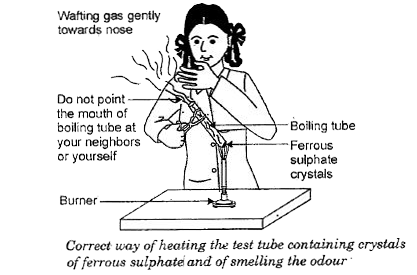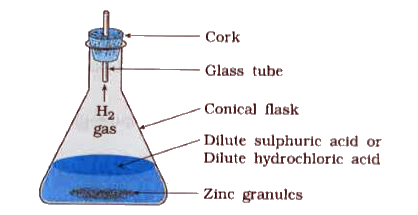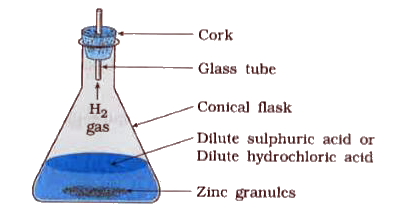• Take a few zinc granules in a conical flask or a test tube.
• Add dilute hydrochloric acid or sulphuric acid to fig.

CAUTION : Handle the acid with care.
Touch the conical flask or test tube. Is there change in its temperature ? Solution in Punjabi
Yes, its temperature is slightly increased.
Note: From the above three activities, we can conclude the following observations that help us to determine together a chemical reaction has taken place
1. change in state
2. change in colour
3. evolution of gas
4. change in temperature.
Topper's Solved these Questions
- CHEMICAL REACTIONS AND EQUATIONSBOOK - NAND LAL PUBLICATIONCHAPTER - CHEMICAL REACTIONS AND EQUATIONSEXERCISE - ACTIVITY 1.4
1 Videos
- CHEMICAL REACTIONS AND EQUATIONSBOOK - NAND LAL PUBLICATIONCHAPTER - CHEMICAL REACTIONS AND EQUATIONSEXERCISE - ACTIVITY 1.5
1 Videos
- CHEMICAL REACTIONS AND EQUATIONSBOOK - NAND LAL PUBLICATIONCHAPTER - CHEMICAL REACTIONS AND EQUATIONSEXERCISE - ACTIVITY 1.2
1 Videos
- CARBON AND ITS COMPOUNDSBOOK - NAND LAL PUBLICATIONCHAPTER - CARBON AND ITS COMPOUNDSEXERCISE - ADDITIONAL QUESTIONS
3 Videos
- METALS AND NON-METALSBOOK - NAND LAL PUBLICATIONCHAPTER - METALS AND NON-METALSEXERCISE - ACTIVITY 3.8
3 Videos
Similar Questions
• Take a small amount of calcium oxide or quick lime in beaker.
• Slowly add water to this.

• Touch the beaker as shown in Fig.
Do you feel any change in temperature?
View Solution•Take about 2 g ferrous sulphate crystals in a dry bottle tube.
• Note the colour of the ferrous sulphate crystals.
• Heat the boiling tube over the flame of a burner or spirit lamp as shown in Fig.

Observe the colour of the crystals after heating.
View Solution• Take lead nitrate solution in a test tube.
• Add potassium iodide solution to this.
What do you observe ?
View SolutionName the alcohol which constitutes glyceride.
View SolutionIs the product formed on burning magnesium acidic or basic?
View SolutionApparatus: Test tube, conical flask, balance, etc.
Chemicals: Sodium chloride and silver nitrate.
Procedure:
i. Take sodium chloride solution in a conical flask and silver nitrate solution in a test tube.
ii. Tie a thread to the test tube and insert it carefully into the conical flask. Make the conical flask air tight by fitting a rubber cork.
iii. Weigh the conical flask with the help of a balance.
iv. Now tilt the conical flask and mix the solution present in the test tube with the solution in the conical flask.
v. Weigh the conical flask again.
Which changes did you find?
View SolutionApparatus: Test tube, conical flask, balance, etc.
Chemicals: Sodium chloride and silver nitrate.
Procedure:
i. Take sodium chloride solution in a conical flask and silver nitrate solution in a test tube.
ii. Tie a thread to the test tube and insert it carefully into the conical flask. Make the conical flask air tight by fitting a rubber cork.
iii. Weigh the conical flask with the help of a balance.
iv. Now tilt the conical flask and mix the solution present in the test tube with the solution in the conical flask.
v. Weigh the conical flask again.
Did any insoluble substance form?
View SolutionApparatus: Test tube, conical flask, balance, etc.
Chemicals: Sodium chloride and silver nitrate.
Procedure:
i. Take sodium chloride solution in a conical flask and silver nitrate solution in a test tube.
ii. Tie a thread to the test tube and insert it carefully into the conical flask. Make the conical flask air tight by fitting a rubber cork.
iii. Weigh the conical flask with the help of a balance.
iv. Now tilt the conical flask and mix the solution present in the test tube with the solution in the conical flask.
v. Weigh the conical flask again.
Was there any change in the weight?
View SolutionApparatus: Test tube, conical flask, balance, etc.
Chemicals: Sodium chloride and silver nitrate.
Procedure:
i. Take sodium chloride solution in a conical flask and silver nitrate solution in a test tube.
ii. Tie a thread to the test tube and insert it carefully into the conical flask. Make the conical flask air tight by fitting a rubber cork.
iii. Weigh the conical flask with the help of a balance.
iv. Now tilt the conical flask and mix the solution present in the test tube with the solution in the conical flask.
v. Weigh the conical flask again.
Which changes did you find?
View SolutionApparatus: Test tube, conical flask, balance, etc.
Chemicals: Sodium chloride and silver nitrate.
Procedure:
i. Take sodium chloride solution in a conical flask and silver nitrate solution in a test tube.
ii. Tie a thread to the test tube and insert it carefully into the conical flask. Make the conical flask air tight by fitting a rubber cork.
iii. Weigh the conical flask with the help of a balance.
iv. Now tilt the conical flask and mix the solution present in the test tube with the solution in the conical flask.
v. Weigh the conical flask again.
Did any insoluble substance form?
View SolutionApparatus: Test tube, conical flask, balance, etc.
Chemicals: Sodium chloride and silver nitrate.
Procedure:
i. Take sodium chloride solution in a conical flask and silver nitrate solution in a test tube.
ii. Tie a thread to the test tube and insert it carefully into the conical flask. Make the conical flask air tight by fitting a rubber cork.
iii. Weigh the conical flask with the help of a balance.
iv. Now tilt the conical flask and mix the solution present in the test tube with the solution in the conical flask.
v. Weigh the conical flask again.
Was there any change in the weight?
View SolutionAim: To study the reaction between zinc metal and dilute sulphuric acid.
Caution: Use the acid with care.
Activity:
Take a conical flask.
Add a piece of zinc granules in it.
Then add dilute hydrochloric acid or dilute sulphuric acid.

What appears around the zinc granules ?
View SolutionAim: To study the reaction between zinc metal and dilute sulphuric acid. Caution: Use the acid with care. Activity: Take a conical flask. Add a piece of zinc granules in it. Then add dilute hydrochloric acid or dilute sulphuric acid. What happens to the conical flask ?
View SolutionAim: To study the reaction between zinc metal and dilute sulphuric acid. Caution: Use the acid with care. Activity: Take a conical flask. Add a piece of zinc granules in it. Then add dilute hydrochloric acid or dilute sulphuric acid. State the reaction occurring between the pieces of zinc and dilute HCl.
View SolutionAim: To study the reaction between zinc metal and dilute sulphuric acid.
Caution: Use the acid with care.
Activity:
Take a conical flask.
Add a piece of zinc granules in it.
Then add dilute hydrochloric acid or dilute sulphuric acid.

Which type of reaction takes place between the pieces of zinc and dilute HCI ?
View Solutionഒരു ടെസ്റ്റ് ട്യൂബില് 5ml നേര്പ്പിച്ച ഹൈഡ്രോക്ലോറിക് ആസിഡ് എടുത്ത് അതിലേക്ക് അല്പ്പം സിങ്ക് തരികള് ഇടുക. ടെസ്റ്റ് ട്യൂബിന്റെ വായ് ഭാഗത്ത് കത്തിച്ച തീപ്പെട്ടികൊള്ളി കൊണ്ടുവരിക എന്താണ് നിരീക്ഷിച്ചത്?
View Solution
